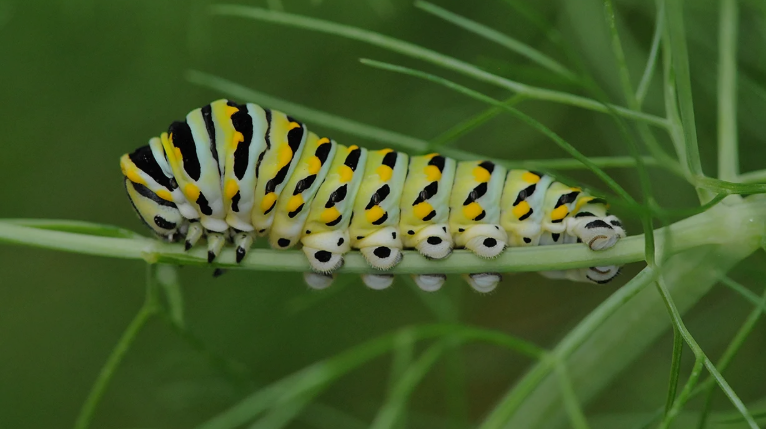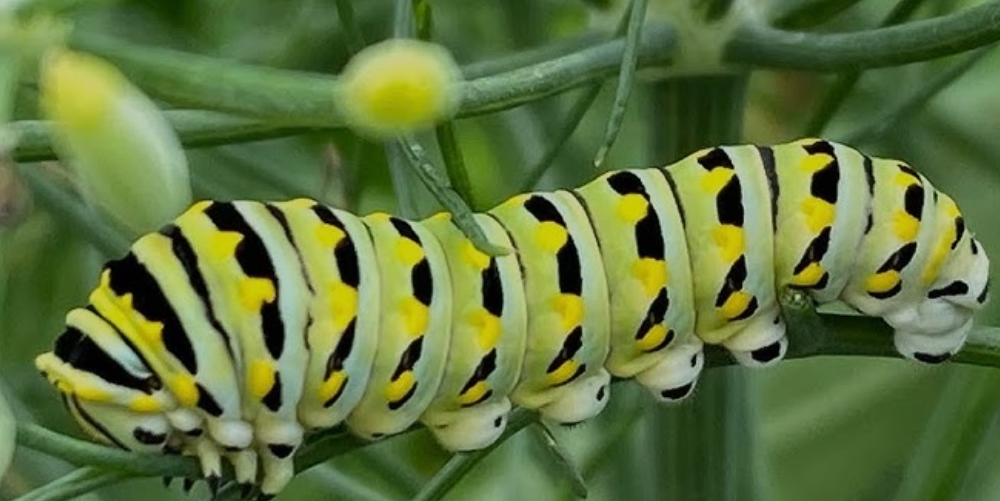
Swallowtail caterpillars belong to the butterfly family Papilionidae, which includes over 550 species worldwide. This family is divided into several genera, with each genus exhibiting unique larval traits, feeding habits, and ecological adaptations. The most prominent genera include Papilio, Battus, Iphiclides, and Parides, among others. These caterpillars are famous for their remarkable defensive strategies, including camouflage, mimicry, and chemical defenses, which allow them to survive predation during their vulnerable larval stage. Across genera, these adaptations vary widely, reflecting the diverse habitats and host plants they occupy.
The genus Papilio is the largest and perhaps the most recognizable. It includes well-known species such as the Eastern and Western Tiger Swallowtails, Black Swallowtail, and Giant Swallowtail. Caterpillars in this genus often exhibit bird-dropping mimicry in early instars, turning green or brown with distinctive eye spots as they mature. Many species feed on trees and shrubs, including citrus, poplar, ash, and willow. Their osmeterium, a forked defensive gland that releases a foul odor, is a hallmark of the genus and is used to repel birds and other predators.
The genus Battus primarily includes caterpillars that feed on pipevines (Aristolochia spp.) and other toxic plants. Species such as the Pipevine Swallowtail (Battus philenor) sequester toxins from their host plants, which make both the larva and the adult butterfly unpalatable. Caterpillars in this genus are often dark-colored with fleshy tubercles, serving as a warning to predators (aposematic coloration). Unlike Papilio, their camouflage is less about blending in and more about signaling toxicity.
Another interesting genus is Iphiclides, which includes the Scarce Swallowtail. Caterpillars in this genus are typically green with black transverse stripes and orange or yellow spots, providing effective camouflage among leaves. These caterpillars are usually associated with fruit trees, such as cherries and plums, and rely heavily on both visual and chemical defenses. The genus showcases how evolutionary pressures, like predation and host plant specialization, drive diversity in larval forms and strategies.
The genus Parides is primarily found in Central and South America. Caterpillars in this genus are often brightly colored or patterned, feeding on specific host plants that allow them to acquire chemical defenses. Their striking colors act as a warning to potential predators, a strategy known as aposematism. Across all swallowtail genera, larval adaptations reflect a balance between avoiding detection, deterring predators, and exploiting available host plants, making swallowtail caterpillars some of the most fascinating and ecologically important larvae in the Lepidoptera order.

Species of Swallowtail Caterpillars
Eastern Tiger Swallowtail Caterpillar (Papilio glaucus)
The Eastern Tiger Swallowtail caterpillar is remarkable for its defensive mimicry. When young, it resembles bird droppings, offering camouflage. As it matures, it becomes green with large, false eye spots on its thorax, giving it a snake-like appearance to ward off predators. It feeds on trees like tulip poplar, magnolia, and wild cherry.
Black Swallowtail Caterpillar (Papilio polyxenes)
Sometimes called the “parsley caterpillar,” this species is bright green with black bands and yellow spots, resembling a striped cylinder. It feeds on plants of the carrot family, such as dill, fennel, parsley, and carrot tops, making it a familiar garden visitor.
Spicebush Swallowtail Caterpillar (Papilio troilus)
This caterpillar is famous for its convincing snake mimicry. Early instars look like bird droppings, while later ones turn bright green or yellow-green with large eye-like spots. They curl up inside leaves of spicebush or sassafras, creating shelters for protection during the day.
Pipevine Swallowtail Caterpillar (Battus philenor)
Unlike many green swallowtail larvae, this caterpillar is dark reddish-brown to black with rows of fleshy orange or red tubercles along its body. It feeds on pipevine (Aristolochia spp.), which makes it toxic and unpalatable to predators. Adults retain this chemical defense.
Giant Swallowtail Caterpillar (Papilio cresphontes)
Nicknamed the “orange dog,” this caterpillar camouflages itself as bird droppings with its mottled brown, white, and cream body. It feeds on citrus trees and other members of the rue family, making it a common sight in citrus-growing regions of North America.
Old World Swallowtail Caterpillar (Papilio machaon)
This species, found across Europe, Asia, and North America, is vividly patterned. The mature caterpillar is green with black transverse bands dotted with orange spots. It commonly feeds on members of the carrot family, much like the Black Swallowtail.
Polydamas Swallowtail Caterpillar (Battus polydamas)
This caterpillar is deep maroon or black with long fleshy tubercles, similar in appearance to the Pipevine Swallowtail caterpillar. It also feeds on pipevines and inherits chemical defenses from its host plants.
Western Tiger Swallowtail Caterpillar (Papilio rutulus)
A close relative of the Eastern Tiger Swallowtail, this species also has striking snake-like false eyes in its later instars. Its main host plants include poplars, willows, and alders, and it is native to western North America.
Lime Swallowtail Caterpillar (Papilio demoleus)
A widespread species found in Asia and parts of Africa, the Lime Swallowtail caterpillar is an agricultural pest on citrus trees. Like the Giant Swallowtail, it disguises itself as bird droppings when young, shifting to a green color as it matures.
Two-tailed Swallowtail Caterpillar (Papilio multicaudata)
This large caterpillar also employs mimicry. Mature larvae are green with large false eye spots and feed on ash, chokecherry, and other trees. As adults, they develop the distinctive two tails on their hindwings.
Chinese Yellow Swallowtail Caterpillar (Papilio xuthus)
Native to East Asia, the Chinese Yellow Swallowtail caterpillar is green with subtle black or brown markings that help it blend in with citrus and rutaceous plants. Young caterpillars often mimic bird droppings, while older instars display small eye spots on the thorax. It is a common species in orchards and gardens, feeding primarily on citrus leaves.
Madagascan Swallowtail Caterpillar (Papilio demodocus)
This species is found on the island of Madagascar and nearby African regions. Its larvae are green with faint yellow stripes and black markings, providing excellent camouflage on citrus and other host plants. The caterpillar uses an osmeterium for defense and is considered a minor pest on local citrus crops.
African Giant Swallowtail Caterpillar (Papilio antimachus)
Native to tropical Africa, this caterpillar is among the largest in the swallowtail family. It has a green body with subtle white or yellow markings and a long thoracic segment with small tubercles. It primarily feeds on forest trees and shrubs. Its size and striking appearance make it a notable example of tropical swallowtail larvae.
Scarce Swallowtail Caterpillar (Iphiclides podalirius)
Found in parts of Europe and the Middle East, the Scarce Swallowtail caterpillar is light green with black transverse stripes and orange spots along its body. It feeds on members of the Prunus genus, including wild cherry and plum trees. Its coloration provides camouflage among leaves, while the osmeterium serves as a chemical defense.
Hercules Swallowtail Caterpillar (Papilio hercules)
Native to Central and South America, the Hercules Swallowtail caterpillar is a large green larva with black markings and small spiny projections. It feeds on citrus and related trees and is notable for the eventual large size of the adult butterfly, which has striking tail extensions on its hindwings.
Golden Swallowtail Caterpillar (Papilio garamas)
This species is found in Mexico and parts of Central America. The caterpillar is green with golden-yellow spots and subtle black lines, providing excellent camouflage among leaves of Rutaceae plants. Its protective osmeterium helps deter predators, and it eventually transforms into a visually striking swallowtail butterfly.